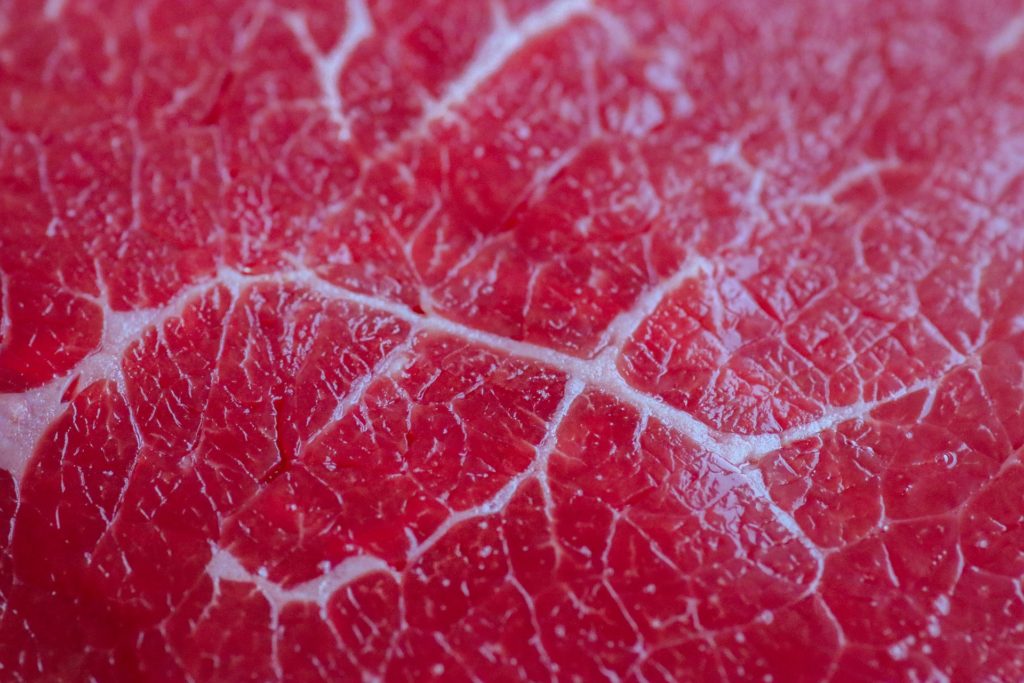
Have you ever wondered why chicken meat is pinkish-white, while beef is cherry red? The predominant pigment and its concentration contained in the meat determines the meat color. There are actually two major pigments responsible for this: myoglobin and hemoglobin.
Although myoglobin composes 80 to 90% of the total meat pigment. Myoglobin is a red-colored, oxygen-binding protein in the animal muscle, whereas hemoglobin carries oxygen to the bloodstream. Hemoglobin is present at 10 to 20% in well-bled meat.
During cooking, myoglobin may be used as an indication of doneness of meat. Exposure to heat denatures the myoglobin protein, changing the color of the meat from purple or red to pale gray-brown.
Myoglobin also takes part in the formation of the appealing color of cured meat. Sodium nitrite is a common curing agent in meat products such as ham. What happens here is that the nitrite is converted to nitric oxide. Then, the nitric oxide reacts with myoglobin to form nitric oxide myoglobin, which is responsible for the red color of uncured meat. The curing process changes the color of the meat to the characteristic bright pink color.
Meats have different colors because of the varying levels of myoglobin they contain. Of course, the higher the levels of myoglobin, the redder or darker the meat. There are several factors that determine the concentration of myoglobin in meat.

FREQUENTLY EXERCISED MEAT PORTION IS DARKER
One factor is how often the muscle is used when the animal was alive. Generally, myoglobin is in higher levels in parts of the meat that expends more oxygen during movement.
If you observe a raw chicken meat, the breast meat is white. Breast muscle aids in flapping wings, so it only requires short bursts of energy and less oxygen. Raw chicken meat contains 0.05% myoglobin and is pinkish-white. But the same thing cannot be said to the leg part. The power daily walking of chicken makes the leg darker. For more detail on the differences between white and dark chicken meat, check out this article.
The leg muscle is darker also in pork meat. Pork has an average myoglobin content of 0.2% and is reddish-pink. The loin meat on the back is both light and dark, so it requires some flavoring when cooked.
You might also like: Meat Science: Is Brown Meat Bad?
Duck meat contains more myoglobin than both pork and chicken meat. Duck meat contains an average myoglobin content of 0.3%. Always moving around, ducks require darker, fatty muscle for stamina. The good thing is that the fat intensifies the flavor, so little flavoring is needed during cooking.
Lamb meat is reddish-pink, and contains an average myoglobin content of 0.6%. Cuts at the top of the leg is darker. The high levels of myoglobin and fat provide juiciness and flavor.
Beef is cherry red because it contains more myoglobin than most meats. On average, its myoglobin content is 0.8%. Cows use their slow-twitch muscle to roam around. Myoglobin and fat give beef its juiciness and flavor, so less flavoring is necessary when cooking. Dark meat contains more myoglobin, fat, iron, and zinc than white meat.
AS THE ANIMAL GROWS OLDER, THE MYOGLOBIN LEVELS INCREASE
Meats of older animals contain higher levels of myoglobin. The reason for this is that their muscles have been worked more. They have denser meat and stronger connective tissue.
Lamb is meat from sheep not older than 1 year, and is preferred by many in the United States. Its color is reddish pink because its myoglobin content is 0.6%. Mutton is meat from sheep older than 1 year, and is enjoyed more in Europe and in the middle East. Its color is intense red. Its myoglobin content is 1.4%, more than twice as much as that in lamb. The combination of fat and myoglobin give mutton a stronger flavor than lamb.
BLOOD OR MYOGLOBIN?
This is one of the most talked about on the internet. Is that blood on your steak? Or myoglobin? Often times, you’ll find a red liquid in the bottom of the packaging. Most people would say it is blood. Another similar case is a plate of “bloody” steak at a restaurant. The truth is that red liquid is not blood. But myoglobin and water, or myowater. Before the meat reaches the market, the slaughtering process ensures that blood have been removed. If that red liquid were blood, it would be dark, like almost black, and it would coagulate on your plate of steak.
You might also like: Science Says Never Have Your Steak Well Done
A “bloody” steak usually happens when cooked rare. Well, even meat that is intense red is bloodless. A steak well done has been cooked thoroughly and is grayish brown only because myoglobin has been denatured.



Pingback:Can Chicken Be a Little Pink Inside and Still Be Safe? - BBQ Host
Pingback:Steak Turned Brown in Freezer: What Causes This Phenomenon? - BBQ Host
Pingback:Mastering Meat Smoking: Temperature Control Made Easy